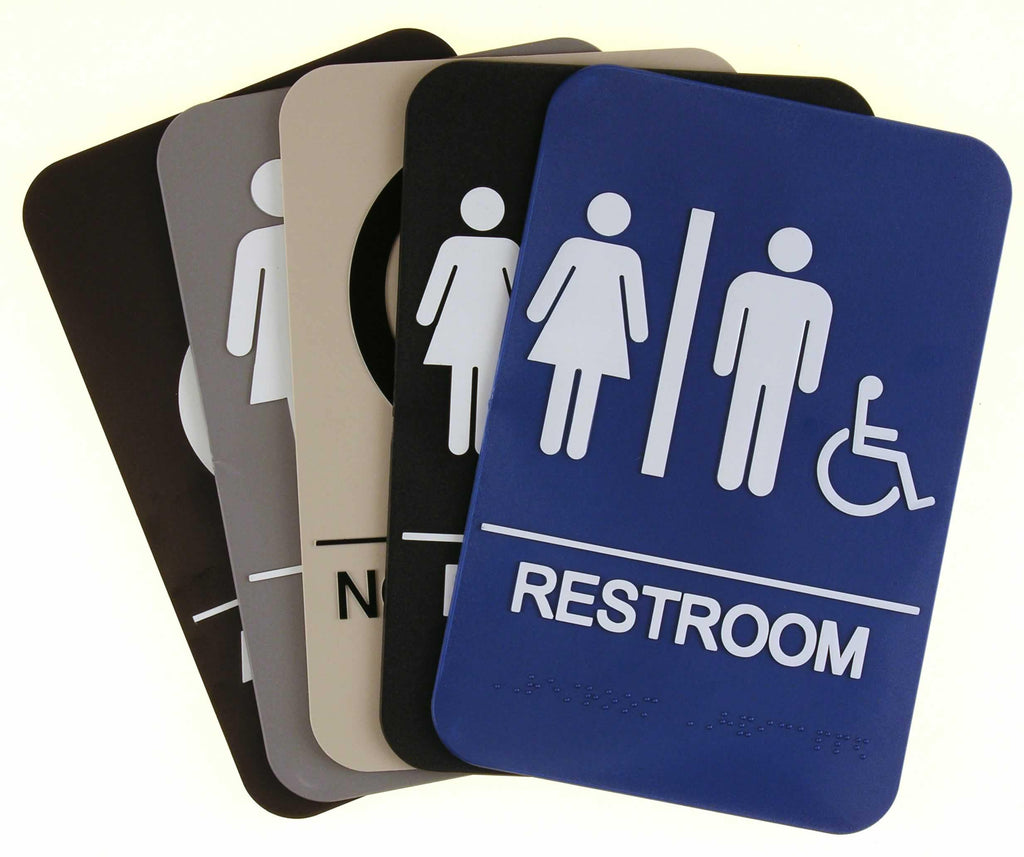The Benefits of Using Top Notch ADA Signs in Your Service
The Benefits of Using Top Notch ADA Signs in Your Service
Blog Article
Discovering the Secret Functions of ADA Signs for Boosted Accessibility
In the realm of ease of access, ADA signs offer as silent yet effective allies, making certain that rooms are navigable and inclusive for individuals with impairments. By integrating Braille and responsive components, these indicators damage barriers for the aesthetically damaged, while high-contrast color plans and readable typefaces provide to diverse visual needs.
Value of ADA Compliance
Making certain conformity with the Americans with Disabilities Act (ADA) is important for fostering inclusivity and equal gain access to in public spaces and workplaces. The ADA, enacted in 1990, mandates that all public facilities, employers, and transport services accommodate people with impairments, guaranteeing they enjoy the same civil liberties and chances as others. Compliance with ADA requirements not just fulfills lawful commitments however likewise improves an organization's reputation by showing its commitment to diversity and inclusivity.
Among the key facets of ADA compliance is the application of easily accessible signage. ADA indicators are developed to guarantee that individuals with impairments can quickly browse via spaces and structures. These signs should stick to specific guidelines regarding dimension, typeface, color contrast, and positioning to ensure exposure and readability for all. Effectively carried out ADA signage helps get rid of barriers that individuals with specials needs frequently come across, consequently promoting their freedom and self-confidence (ADA Signs).
Additionally, sticking to ADA laws can reduce the danger of possible penalties and legal repercussions. Organizations that fall short to adhere to ADA standards might encounter fines or suits, which can be both financially difficult and destructive to their public picture. Thus, ADA compliance is essential to promoting an equitable setting for everybody.
Braille and Tactile Aspects
The consolidation of Braille and tactile components into ADA signage embodies the concepts of accessibility and inclusivity. These functions are vital for people that are aesthetically damaged or blind, enabling them to navigate public rooms with higher self-reliance and confidence. Braille, a tactile writing system, is necessary in giving written information in a layout that can be conveniently viewed with touch. It is usually positioned underneath the equivalent text on signage to guarantee that people can access the details without visual assistance.
Tactile elements prolong past Braille and include raised characters and signs. These elements are designed to be discernible by touch, enabling people to identify space numbers, restrooms, leaves, and other crucial areas. The ADA establishes details guidelines concerning the dimension, spacing, and placement of these tactile aspects to maximize readability and guarantee consistency across different environments.

High-Contrast Color Pattern
High-contrast color pattern play a crucial role in improving the presence and readability of ADA signs for people with aesthetic impairments. These systems are crucial as they take full advantage of the difference in light reflectance between message and history, making sure that signs are quickly discernible, also from a distance. The Americans with Disabilities Act (ADA) mandates making use of particular color contrasts to accommodate those content with minimal vision, making it a crucial element of compliance.
The efficacy of high-contrast colors hinges on their capacity to stick out in various lights problems, including dimly lit environments and locations with glare. Generally, dark message on a light background or light text on a dark background is utilized to achieve ideal comparison. Black text on a white or yellow history supplies a plain visual distinction that aids in quick recognition and understanding.

Legible Fonts and Text Dimension
When considering the style of ADA signage, the choice of understandable fonts and suitable text size can not be overstated. The Americans with Disabilities Act (ADA) mandates that typefaces have to be sans-serif and not italic, oblique, script, highly ornamental, or of uncommon type.
The dimension of the message also plays a crucial role in access. According to ADA guidelines, the minimal text height must be 5/8 inch, and it must increase proportionally with watching distance. This is specifically vital in public spaces where signage demands to be reviewed rapidly and accurately. Uniformity in message size adds to a natural aesthetic experience, assisting individuals in navigating settings effectively.
Furthermore, spacing between letters and lines is indispensable to readability. Sufficient spacing protects against characters from appearing crowded, boosting readability. By adhering to these standards, developers can considerably boost availability, ensuring that signs offers its intended objective for all individuals, despite their aesthetic capacities.
Effective Positioning Strategies
Strategic placement of ADA signage is crucial for optimizing ease of access and making sure conformity with legal requirements. Correctly positioned indications lead people with specials needs successfully, promoting navigation in public spaces. Secret factors to consider include proximity, exposure, and height. ADA standards specify that signs should be mounted at a height between 48 to 60 inches from the ground to ensure they are within the line of sight for both standing and seated individuals. This conventional elevation variety is important for inclusivity, making it possible for mobility device customers and people of differing elevations to gain access to info easily.
Additionally, indicators need to be placed surrounding to the latch side of doors to allow very easy identification prior to entrance. Uniformity in indication placement throughout a center enhances predictability, minimizing confusion and boosting overall customer experience.

Conclusion
ADA indications play a vital function in advertising ease find out this here of access by incorporating attributes that deal with the demands of people with impairments. Integrating Braille and responsive elements guarantees essential information comes to the aesthetically damaged, while high-contrast color pattern and legible sans-serif fonts enhance exposure throughout numerous illumination conditions. Effective positioning methods, such as suitable installing heights and calculated places, even more facilitate navigating. These aspects jointly promote an inclusive atmosphere, emphasizing article the relevance of ADA conformity in ensuring equal access for all.
In the world of access, ADA indicators offer as silent yet powerful allies, ensuring that rooms are inclusive and accessible for people with specials needs. The ADA, passed in 1990, mandates that all public facilities, companies, and transport services suit people with impairments, ensuring they appreciate the very same legal rights and opportunities as others. ADA Signs. ADA indicators are created to guarantee that people with specials needs can quickly navigate via buildings and spaces. ADA standards state that signs must be mounted at an elevation between 48 to 60 inches from the ground to guarantee they are within the line of sight for both standing and seated people.ADA indications play a vital duty in promoting access by integrating attributes that attend to the needs of people with disabilities
Report this page